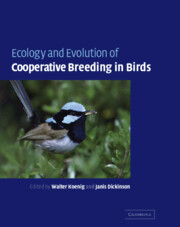Book contents
- Frontmatter
- Contents
- List of contributors
- Introduction
- 1 Evolutionary origins
- 2 Delayed dispersal
- 3 Fitness consequences of helping
- 4 Parental care, load-lightening, and costs
- 5 Mating systems and sexual conflict
- 6 Sex-ratio manipulation
- 7 Physiological ecology
- 8 Endocrinology
- 9 Incest and incest avoidance
- 10 Reproductive skew
- 11 Joint laying systems
- 12 Conservation biology
- 13 Mammals: comparisons and contrasts
- 14 Summary
- Names of bird and mammal species mentioned in the text
- References
- Taxonomic index
- Subject index
12 - Conservation biology
Published online by Cambridge University Press: 02 December 2009
- Frontmatter
- Contents
- List of contributors
- Introduction
- 1 Evolutionary origins
- 2 Delayed dispersal
- 3 Fitness consequences of helping
- 4 Parental care, load-lightening, and costs
- 5 Mating systems and sexual conflict
- 6 Sex-ratio manipulation
- 7 Physiological ecology
- 8 Endocrinology
- 9 Incest and incest avoidance
- 10 Reproductive skew
- 11 Joint laying systems
- 12 Conservation biology
- 13 Mammals: comparisons and contrasts
- 14 Summary
- Names of bird and mammal species mentioned in the text
- References
- Taxonomic index
- Subject index
Summary
The primary objective of conservation is to preserve biodiversity. Biodiversity encompasses not only distinct life forms such as species and subspecies, but also unique adaptations such as cooperative breeding. Cooperatively breeding birds exhibit a variety of distinctive traits that render some species unusually vulnerable to, or resistant to, habitat loss, degradation, and fragmentation, and to the problems inherent to small populations. Especially relevant are extreme philopatry, sensitivity to habitat quality, and the presence of large numbers of non-breeding adults (helpers). To our knowledge, no one has previously assessed how cooperative breeders as a group are faring against the threats to their continued existence they currently face. In this chapter we conduct such an assessment and examine the interaction between the distinctive features of cooperative breeders and the various threats to biodiversity.
In the absence of a body of previous work, we take a simplistic approach and look for broad, general patterns rather than attempting complex analyses. The existing data simply will not support the latter, compelling us to propose hypotheses rather than test them. We fully recognize that, given the diverse ecologies of cooperatively breeding birds (Chapter 5), there will be numerous exceptions to any generalization made about the group. We also recognize that many generalizations will apply to some of the diverse array of cooperative breeding systems but not others, for example to systems with singular breeders assisted by natal helpers but not to systems with plural breeders.
- Type
- Chapter
- Information
- Ecology and Evolution of Cooperative Breeding in Birds , pp. 197 - 209Publisher: Cambridge University PressPrint publication year: 2004
- 17
- Cited by



